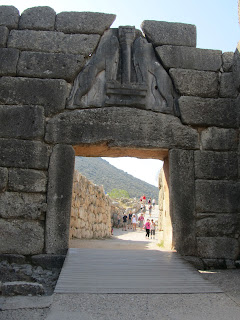The third day of the tour dawned early and bright. That morning we were going to the site of ancient Mycenae to see the former palace. Many years ago I studied a year of Ancient History at St Andrews as a minor subject as part of my degree and I remember clearly Professor Rickman lecturing us about Schliemann and Evans' discoveries but not the details. Whilst I teach English literature and Law, History is possibly my greatest love: to the point where I couldn't ruin it by teaching it. Due to the passage of years since I studied it I had forgotten much of the detail of the Mycenean civilisation and it was a real pleasure to go to the site and be reminded.
The first part of the visit was to a tholos or beehive tomb at a distance from the site. It's known as the Treasury of Atreus after the somewhat bloodthirsty Homeric story of King Atreus who had his nieces and nephews cooked and served to their father, his brother, in revenge. The photos cannot hope to make clear how huge the rocks that form the tomb are or just how breathtaking it is inside, particularly as it would have been constructed somewhere around 1500 BC.
The photo below shows the entrance (or dromos) and the lintel above the door is a single slab of rock estimated at 120 tons in weight. This weight is incredible when you consider that this was constructed in the Bronze Age before any mechanical heavy lifting equipment was available. It is believed that the triangular shape above the lintel was put there to ensure that, when an earthquake occurred, the forces would crack the lintel to the side and preserve the doorway rather than in the centre, which would bring the entire structure down. If you look carefully at the left of the lintel you will see a crack which was caused by an earthquake and it follows the line of the triangle above.
The main acropolis of Mycenae was across the road and is a stunningly beautiful place, built high above a gorge on one side for protection and with views across Greece to the sea in the distance.
Mycenae was the city that Homer described as 'rich in gold'. In the Homeric epics it is where Helen is kidnapped from Menelaus, her husband, by Trojan prince, Paris. If you don't have time to read the Iliad at the moment you could use one of the two sources I used on the holiday to remind myself of the stories: the first is the brilliant Orange prize winning novel The Song of Achilles by Madeleine Miller which is a truly beautiful retelling of Homer or the utterly brilliant Horrible Histories retelling (please watch this, it's hilarious). Schliemann named many of the sites after the rather unpleasant Atrean kings and queens, but as the Myceneans only used writing for business, not history, it's impossible to tell whether Agamemnon, Klytemnestra or Menelaus were ever real.
The Grave Circle A is where the Schliemann uncovered a death mask and a body so well preserved that, for a second, he could see the facial features of the warrior before it turned to dust. He sent a wire to the King of Greece claiming 'I have gazed on the face of Agamemnon' but whether it was, who knows?
Grave Circle A and the death mark (now in the Archaeological museum of Athens)
Mycenae also has the famous Lion Gate which is one of the earliest remaining pieces of representational art in Greek culture. The lions' heads were originally separate and possibly gold, certainly by the visit of Pausanius in the 2nd centure AD they were long gone.
The rest of the site is beautiful but not a great deal remains. We looked around and my son had a brilliant time pretending to 'take' the postern gate.
Later in the day we travelled to Sparta for an overnight stay. Sparta is now a modern city built near the ruins of the Ancient city. Fascinatingly, it has not been excavated and I do feel that part of the reason is that Sparta has had a terrible rap from history in comparison to the much-admired Athenian society. The Spartan ideal of the warrior is certainly alien to us: they studied from age 7 and did not get their freedom from the army until 60. However, women in Spartan society were certainly much better treated than Athenian women as this Horrible Histories Historical Wife Swap demonstrates. My son and I went to look at the statue of Leonidas and then to look around the unexcavated, but still evocative, ruins of ancient Sparta.











No comments:
Post a Comment